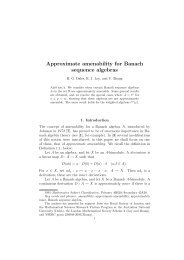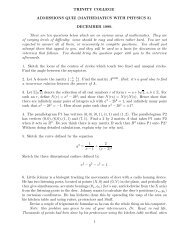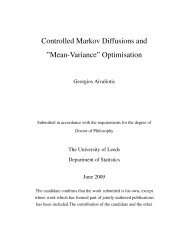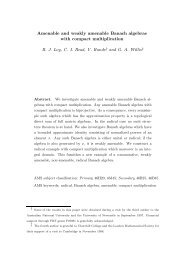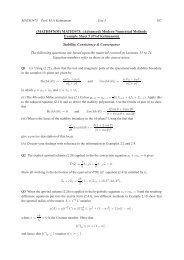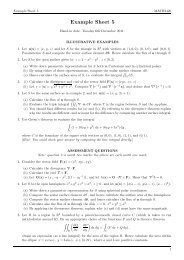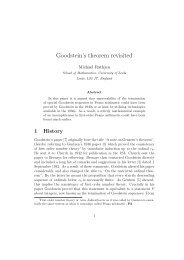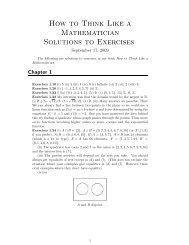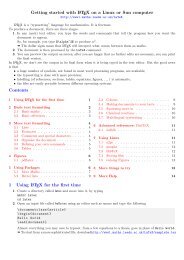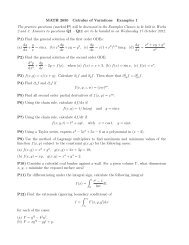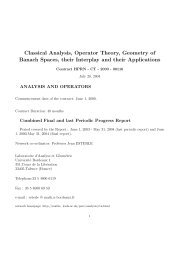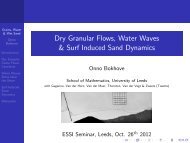A. MALIDI, S. DUFOUR AND D. N’DRIcomputer simulations <strong>of</strong> multiuid ows [1]. In this <strong>study</strong>, we are particularly interested ina family <strong>of</strong> methods based on a marker variable that is used to identify <strong>the</strong> region occupiedby each uid. The zero thickness interface is traded <strong>for</strong> a transition zone <strong>of</strong> <strong>the</strong> marker.This variable is <strong>the</strong>n transported by <strong>the</strong> velocity eld <strong>of</strong> each uid, by solving a transportequation <strong>of</strong> <strong>the</strong> marker on a xed grid. This Eulerian approach, which is also known asfree surface capturing, is popular <strong>for</strong> <strong>modelling</strong> complex multiuid ows. Among <strong>the</strong> mostpopular free surface capturing methods we can mention <strong>the</strong> volume <strong>of</strong> uid method [2],<strong>the</strong> level set method [3], and <strong>the</strong> pseudo-concentration method [4], to name a few. Thisapproach is better suited <strong>for</strong> <strong>modelling</strong> <strong>the</strong> evolution <strong>of</strong> free surfaces submitted to largeand complex de<strong>for</strong>mations. Modelling multiple interface ows is not a complicated matter,since <strong>the</strong> interface is not treated as an explicit computational entity. Free surface splittingand reconnection are handled implicitly. However, this strategy is known to be lessaccurate if <strong>the</strong> <strong>numerical</strong> strategy is not well chosen. This is due to <strong>the</strong> uncertaintyinherent in <strong>the</strong> use <strong>of</strong> <strong>the</strong> region <strong>of</strong> transition <strong>of</strong> <strong>the</strong> marker variable to locate <strong>the</strong> free surface,which makes it impossible to impose interfacial boundary conditions explicitly. Freesurface capturing methods are also known to suer from <strong>numerical</strong> diusion or oscillations[5]. This results in <strong>the</strong> de<strong>for</strong>mation <strong>of</strong> <strong>the</strong> region <strong>of</strong> transition <strong>of</strong> <strong>the</strong> markervariable, and <strong>the</strong>re<strong>for</strong>e to mass-conservation problems and to an inaccurate <strong>modelling</strong> <strong>of</strong>interfacial physics. It is <strong>the</strong>re<strong>for</strong>e important to choose <strong>the</strong> right <strong>numerical</strong> strategy inorder to per<strong>for</strong>m an accurate transport <strong>of</strong> <strong>the</strong> free surfaces, and to conserve mass <strong>for</strong>each uid.Several components in a <strong>numerical</strong> methodology inuence <strong>the</strong> accuracy <strong>of</strong> a free surfacecapturing strategy. An inaccurate discretization may lead to an imbalance between <strong>the</strong> viscous<strong>for</strong>ces and <strong>the</strong> capillary <strong>for</strong>ces, which will translate into <strong>numerical</strong> instabilities [6]. It is wellknown that a ‘good’ mesh will provide an accurate discretization <strong>of</strong> <strong>the</strong> variables <strong>of</strong> <strong>the</strong>problem [6]. We also observe that <strong>the</strong> elliptic solvers introduce non-physical oscillations ordiusion when <strong>the</strong> solution <strong>of</strong> a partial dierential equation contains a discontinuity or anabrupt variation [7]. Finally, <strong>the</strong> choice <strong>of</strong> an appropriate <strong>time</strong> <strong>integration</strong> scheme, to discretize<strong>the</strong> transient term <strong>of</strong> <strong>the</strong> equations, is important to help conserve mass <strong>for</strong> each uid. To ourknowledge, we do not know <strong>of</strong> a <strong>study</strong> relating <strong>the</strong> discretization in <strong>time</strong> to mass-conservationproblems and interfacial instabilities when <strong>modelling</strong> free surface ows using an Eulerianapproach.Authors <strong>study</strong>ing multiuid ows use various <strong>time</strong> <strong>integration</strong> <strong>schemes</strong>. Examples are: <strong>the</strong>backward Euler scheme <strong>for</strong> mold lling problems [8]; <strong>the</strong> trapezoid rule (TR) <strong>for</strong> sloshingproblems [9]; and <strong>the</strong> backward dierentiation <strong>for</strong>mula (BDF) (Gear scheme) <strong>for</strong> dropsdynamics problems [10] to name a few. But <strong>the</strong>se studies do not mention <strong>the</strong> reasons <strong>for</strong><strong>the</strong>se choices. We are proposing to discuss various strategies <strong>for</strong> <strong>the</strong> discretization <strong>of</strong> <strong>the</strong>transient term <strong>of</strong> <strong>the</strong> partial dierential equations involved in <strong>the</strong> <strong>modelling</strong> <strong>of</strong> free surfaceows in an Eulerian context.After introducing <strong>the</strong> semi-discrete nite element methodology used <strong>for</strong> <strong>modelling</strong> free surfaceows using interface capturing, we rst look at <strong>the</strong> <strong>time</strong> discretization <strong>of</strong> <strong>the</strong>Navier–Stokes equations, which is important <strong>for</strong> <strong>modelling</strong> sti free surface ow problems.We <strong>the</strong>n <strong>study</strong> <strong>the</strong> inuence <strong>of</strong> <strong>the</strong> discretization <strong>of</strong> <strong>the</strong> transient term <strong>of</strong> <strong>the</strong> transport equationon mass conservation. We nally propose an overall <strong>time</strong> <strong>integration</strong> strategy <strong>for</strong> <strong>study</strong>ingfree surface ows. Various free surface ow problems are studied to verify and validate <strong>the</strong>proposed <strong>numerical</strong> strategy.Copyright ? 2005 John Wiley & Sons, Ltd.Int. J. Numer. Meth. Fluids (in press)
A STUDY OF TIME INTEGRATION SCHEMES FOR MODELLING FREE SURFACE FLOWS2. MODELLING OF THE PROBLEMConsider <strong>the</strong> free surface ow problem illustrated in Figure 1. The region occupied by <strong>the</strong>rst uid is denoted 1 . The second uid occupies <strong>the</strong> region 2 , and since <strong>the</strong> uids areimmiscible, 1 ∩ 2 = ∅. The computational domain can <strong>the</strong>re<strong>for</strong>e be dened as = 1 ∪ 2 .The interface separating <strong>the</strong> two uids is denoted by S. The unit normal to <strong>the</strong> interface isdenoted n S .The ow <strong>of</strong> each uid is modelled using <strong>the</strong> equations expressing conservation <strong>of</strong> massand momentum. There<strong>for</strong>e, <strong>the</strong> equationsand∇ · u = 0 (1) @u + (u · ∇)u = ∇ · (2)@tmust be solved <strong>for</strong> uids 1 and 2, i.e. on 1 and 2 , respectively, where =−pI + is <strong>the</strong> Cauchy stress tensor, and <strong>the</strong> density <strong>of</strong> <strong>the</strong> uid is denoted . The extra-stress tensor is related to <strong>the</strong> velocity eld by <strong>the</strong> relation =2˙(u)where is <strong>the</strong> viscosity <strong>of</strong> <strong>the</strong> uid, and <strong>the</strong> rate-<strong>of</strong>-strain tensor ˙ is dened by˙(u)= 1 2 (∇u +(∇u)T )The dependent variables <strong>of</strong> <strong>the</strong> problem will <strong>the</strong>re<strong>for</strong>e be denoted u 1 and u 2 <strong>for</strong> <strong>the</strong> velocityeld <strong>of</strong> uids 1 and 2, and <strong>the</strong> pressure <strong>of</strong> <strong>the</strong> uids will be denoted p 1 and p 2 .Boundary conditions can ei<strong>the</strong>r be <strong>of</strong> <strong>the</strong> essential type (Dirichlet boundary conditions):u i = u @ or <strong>of</strong> <strong>the</strong> natural type (Neumann boundary conditions): i · n = t @ , where i =1; 2inour case. The conditions at <strong>the</strong> interface S are [1]: <strong>the</strong> continuity <strong>of</strong> normal velocitiesu 1 · n S = u 2 · n S = u S · n Su 2nΩ 1Ω 2Figure 1. A free surface ow problem.Copyright ? 2005 John Wiley & Sons, Ltd.Int. J. Numer. Meth. Fluids (in press)



